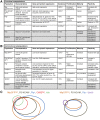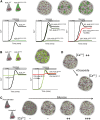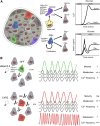New Understanding of β-Cell Heterogeneity and In Situ Islet Function
- PMID: 29559510
- PMCID: PMC5860861
- DOI: 10.2337/dbi17-0040
New Understanding of β-Cell Heterogeneity and In Situ Islet Function
Abstract
Insulin-secreting β-cells are heterogeneous in their regulation of hormone release. While long known, recent technological advances and new markers have allowed the identification of novel subpopulations, improving our understanding of the molecular basis for heterogeneity. This includes specific subpopulations with distinct functional characteristics, developmental programs, abilities to proliferate in response to metabolic or developmental cues, and resistance to immune-mediated damage. Importantly, these subpopulations change in disease or aging, including in human disease. Although discovering new β-cell subpopulations has substantially advanced our understanding of islet biology, a point of caution is that these characteristics have often necessarily been identified in single β-cells dissociated from the islet. β-Cells in the islet show extensive communication with each other via gap junctions and with other cell types via diffusible chemical messengers. As such, how these different subpopulations contribute to in situ islet function, including during plasticity, is not well understood. We will discuss recent findings revealing functional β-cell subpopulations in the intact islet, the underlying basis for these identified subpopulations, and how these subpopulations may influence in situ islet function. Furthermore, we will discuss the outlook for emerging technologies to gain further insight into the role of subpopulations in in situ islet function.
© 2018 by the American Diabetes Association.
Figures



Similar articles
-
β-cell intrinsic dynamics rather than gap junction structure dictates subpopulations in the islet functional network.Elife. 2023 Nov 29;12:e83147. doi: 10.7554/eLife.83147. Elife. 2023. PMID: 38018905 Free PMC article.
-
Systematic single-cell analysis provides new insights into heterogeneity and plasticity of the pancreas.Mol Metab. 2017 Jul 20;6(9):974-990. doi: 10.1016/j.molmet.2017.06.021. eCollection 2017 Sep. Mol Metab. 2017. PMID: 28951822 Free PMC article. Review.
-
Small subpopulations of β-cells do not drive islet oscillatory [Ca2+] dynamics via gap junction communication.PLoS Comput Biol. 2021 May 3;17(5):e1008948. doi: 10.1371/journal.pcbi.1008948. eCollection 2021 May. PLoS Comput Biol. 2021. PMID: 33939712 Free PMC article.
-
The physiological role of β-cell heterogeneity in pancreatic islet function.Nat Rev Endocrinol. 2022 Jan;18(1):9-22. doi: 10.1038/s41574-021-00568-0. Epub 2021 Oct 19. Nat Rev Endocrinol. 2022. PMID: 34667280 Free PMC article. Review.
-
Impact of islet architecture on β-cell heterogeneity, plasticity and function.Nat Rev Endocrinol. 2016 Dec;12(12):695-709. doi: 10.1038/nrendo.2016.147. Epub 2016 Sep 2. Nat Rev Endocrinol. 2016. PMID: 27585958 Review.
Cited by
-
β-cell intrinsic dynamics rather than gap junction structure dictates subpopulations in the islet functional network.Elife. 2023 Nov 29;12:e83147. doi: 10.7554/eLife.83147. Elife. 2023. PMID: 38018905 Free PMC article.
-
Selective monitoring of insulin secretion after CRISPR interference in intact pancreatic islets despite submaximal infection.Islets. 2020 May 3;12(3):59-69. doi: 10.1080/19382014.2020.1752072. Epub 2020 Jun 24. Islets. 2020. PMID: 32579048 Free PMC article.
-
Mitochondrial Dysfunction in Pancreatic Alpha and Beta Cells Associated with Type 2 Diabetes Mellitus.Life (Basel). 2020 Dec 14;10(12):348. doi: 10.3390/life10120348. Life (Basel). 2020. PMID: 33327428 Free PMC article.
-
A KCNK16 mutation causing TALK-1 gain of function is associated with maturity-onset diabetes of the young.JCI Insight. 2021 Jul 8;6(13):e138057. doi: 10.1172/jci.insight.138057. JCI Insight. 2021. PMID: 34032641 Free PMC article.
-
Notch-mediated Ephrin signaling disrupts islet architecture and β cell function.JCI Insight. 2022 Mar 22;7(6):e157694. doi: 10.1172/jci.insight.157694. JCI Insight. 2022. PMID: 35167496 Free PMC article.
References
-
- Pipeleers DG. Heterogeneity in pancreatic beta-cell population. Diabetes 1992;41:777–781 - PubMed
-
- Salomon D, Meda P. Heterogeneity and contact-dependent regulation of hormone secretion by individual B cells. Exp Cell Res 1986;162:507–520 - PubMed
-
- Piston DW, Knobel SM, Postic C, Shelton KD, Magnuson MA. Adenovirus-mediated knockout of a conditional glucokinase gene in isolated pancreatic islets reveals an essential role for proximal metabolic coupling events in glucose-stimulated insulin secretion. J Biol Chem 1999;274:1000–1004 - PubMed
Publication types
MeSH terms
Substances
Grants and funding
LinkOut - more resources
Full Text Sources
Other Literature Sources
Research Materials
Miscellaneous

